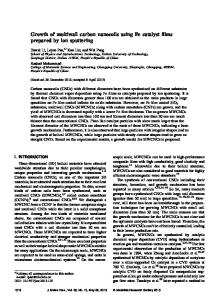Multiwall Carbon Nanotubes by Hydrothermal Treatment
- PDF / 78,260 Bytes
- 4 Pages / 612 x 792 pts (letter) Page_size
- 6 Downloads / 379 Views
Multiwall Carbon Nanotubes by Hydrothermal Treatment Jose M. Calderon-Moreno and Masahiro Yoshimura Center of Materials Design, Tokyo Institute of Technology Nagatsuta 4259, Midori-ku, 226-8503 Yokohama, Japan. ABSTRACT Multiwall carbon nanotubes have been obtained from carbon soot after hydrothermal treatment at 800oC and 100 MPa. High-resolution electron microscopy (HRTEM) study reveals multiwall carbon nanotubes and carbon nanoparticles made of a hollow core enclosed in well-ordered concentric graphitic layers after hydrothermal treatment. Condensed solid products are free of the amorphous phase. Micro-Raman spectroscopy reveals that the hydrothermal multiwall nanotubes have a characteristic perfectly closed graphitic lattice in the basal plane, without edges or plane terminations.
INTRODUCTION Iijima [1] first prepared crystalline carbon nanotubes by using a graphite arc-discharge method, at temperatures exceeding 2000oC. The carbon nanotubes prepared by this method are of good quality, but the yield is low and the production cost high. Twenty years earlier, Baird [2] prepared tubular nanofilaments of much poorer quality by pyrolysis of hydrocarbons; the synthesis mechanism of tubular carbon filaments by pyrolysis of hydrocarbons was first proposed by Tibbet [3] in 1984, and is now generally known as the vapor-liquid-solid (VLS) process. The so-called ‘catalytic’ production methods of carbon nanotubes at temperatures below 1200oC are refinements of the earlier works using a VLS synthesis mechanism to synthesize carbon nanotubes by the pyrolysis of hydrocarbons carried out in the presence of metal transition nanoparticles [4], and the yield of nanotubes is higher than in the arc-discharge method. Unfortunately, the nanotubes synthesized by the so-called ‘catalytic’ methods are of lower quality than those obtained by the arc discharge process and usually covered with thick amounts of amorphous carbon [4-6]. The amorphous part is difficult to separate and remove from the hollow nanotubes. Besides, the complexity involved in methods using gaseous and toxic hydrocarbons is high, so an alternative and easy way should be employed for the synthesis of carbon nanotubes. Multiwall nanotubes with low crystallinity have been previously observed in hot hydrocarbon fluids associated with substantial amounts of amorphous carbon [5-6], but the amorphous part is difficult to separate and remove from the hollow nanotubes. The oxidative effect of hot water on amorphous carbon is currently used for purification of carbon nanotubes from other forms of carbon by hydrothermal treatment (immersion in water at moderates and high temperatures and pressures) [7-8]. However, little is known about the possibilities of hydrothermal method for the synthesis of nano-structured carbons. Hydrothermal processing of carbon is a promising novel technique for obtaining nanostructured carbon materials, including nanotubes and nanocells [9-11]. The aim of the present communication is to introduce hydrothermal synthesis as a new processing method of q
Data Loading...











